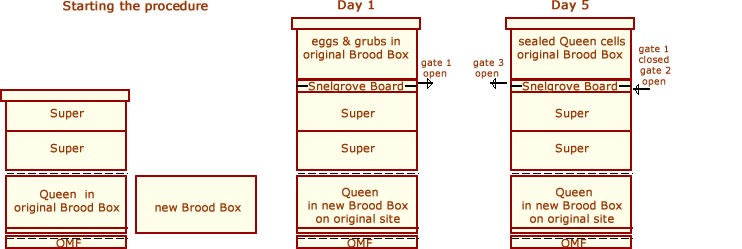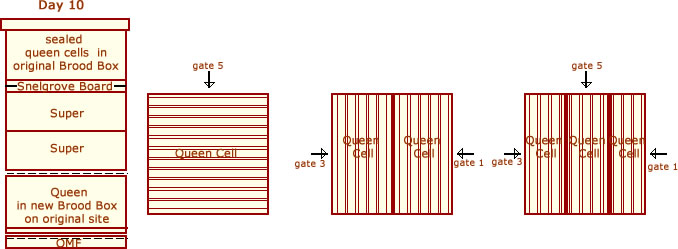Swarm Control 1

1. Place the original brood box with queen to one side and put a new brood box with drawn frames in its place. Leave space for two frames.
2. Go through the original brood box and find the queen. (If the queen cannot be found see below).
3. Place the queen and the frame she is on in the center of the new brood box. Add another frame of sealed brood.
4. Replace the queen excluder, the supers, and place a Snelgrove Board on these and the original brood box on the top. In the top box move the frames together and add two more frames to make up the full compliment. Make sure that there is sufficient stores and pollen in the top box.
5. Open gate 1 (top). The foragers will leave this exit and return to the queen. Foraging will continue and the bees will continue to work on the supers.
6. On day 5 close gate 1 (top) and open gate 2 (lower). Bees which in the meanwhile have learnt to use gate 1 will return but on finding gate 1 closed will use gate 2 and join the queen. At the same time open gate 3 (top); new bees will learnt to use this exit/entrance. Close gate 2 in late evening when all foragers have returned.
7. On day 10 a second gate change can be performed as above allowing still more new forages to join the queen. Close gate 3 (top) and open gate 4 (lower).
8. Ideally queen cells should be formed from grubs which are only one day old; the cell being sealed on the 8th day after the egg is laid. So the first sealed queen cells would be expected on day 5. If sealed queen cells are found before day 5 it would mean that these cells have been formed from grubs over 2 days old. These cells would produce inferior queen and thus should be destroyed. So an inspection is made on day 4 to ensure that there are no sealed queen cells. The position of unsealed queen cells can be marked at this time.
2. Go through the original brood box and find the queen. (If the queen cannot be found see below).
3. Place the queen and the frame she is on in the center of the new brood box. Add another frame of sealed brood.
4. Replace the queen excluder, the supers, and place a Snelgrove Board on these and the original brood box on the top. In the top box move the frames together and add two more frames to make up the full compliment. Make sure that there is sufficient stores and pollen in the top box.
5. Open gate 1 (top). The foragers will leave this exit and return to the queen. Foraging will continue and the bees will continue to work on the supers.
6. On day 5 close gate 1 (top) and open gate 2 (lower). Bees which in the meanwhile have learnt to use gate 1 will return but on finding gate 1 closed will use gate 2 and join the queen. At the same time open gate 3 (top); new bees will learnt to use this exit/entrance. Close gate 2 in late evening when all foragers have returned.
7. On day 10 a second gate change can be performed as above allowing still more new forages to join the queen. Close gate 3 (top) and open gate 4 (lower).
8. Ideally queen cells should be formed from grubs which are only one day old; the cell being sealed on the 8th day after the egg is laid. So the first sealed queen cells would be expected on day 5. If sealed queen cells are found before day 5 it would mean that these cells have been formed from grubs over 2 days old. These cells would produce inferior queen and thus should be destroyed. So an inspection is made on day 4 to ensure that there are no sealed queen cells. The position of unsealed queen cells can be marked at this time.
Swarm Prevention with or without Increase - Snelgrove's Method I
Essentially the colony is made up of 3 parts: i) the queen, ii) the brood and house bees, and iii) the foraging bees. Effective swarm control then entails the separation of one of these parts from the other two.
In this method the queen and foraging bees are separated from the brood and house bees.
Whenever a frame of eggs are raised above the brood box in a separate box, as in the Ben Harden method, it is likely that the bees with raise queen cells on the frame. This knowledge provides a method of swarm prevention with the opportunity to increase the stock by making one, two, or three nucs.
The best time to do this is at the start of the swarming season - from the second week of May and the month of June.
The only requirements are a new brood box with drawn frames and a Snelgrove Board using one, two, or three entrances depending on how many nucs are required.
The procedure is illustrated below on the assumption that the colony is strong and there are no queen cells in the brood box:
Essentially the colony is made up of 3 parts: i) the queen, ii) the brood and house bees, and iii) the foraging bees. Effective swarm control then entails the separation of one of these parts from the other two.
In this method the queen and foraging bees are separated from the brood and house bees.
Whenever a frame of eggs are raised above the brood box in a separate box, as in the Ben Harden method, it is likely that the bees with raise queen cells on the frame. This knowledge provides a method of swarm prevention with the opportunity to increase the stock by making one, two, or three nucs.
The best time to do this is at the start of the swarming season - from the second week of May and the month of June.
The only requirements are a new brood box with drawn frames and a Snelgrove Board using one, two, or three entrances depending on how many nucs are required.
The procedure is illustrated below on the assumption that the colony is strong and there are no queen cells in the brood box:
9. The procedure next depends on how many nucs are wanted; 1, 2, or 3 nicely formed queen cells are chosen respectively.
On day 10 when all queens cells will have been sealed, the top box should be divided accordingly ensuring that each nuc is bee proof as described under the Pagden Method (Swarm Control 3).
New queens emerge on day 16 after the egg is laid, and mating should be completed after the first week. New brood should be seen shortly afterwards.
10. If no increase is required, only one queen cell is left in the top box. This colony is left over the season to develop and then united with the bottom box by the newspaper method after the old queen is either destroyed or removed.
What to do if the queen cannot be found ?
A slightly different approach can be used. The queen is retained in the original brood box and frames of brood transferred to a new box together with sufficien stores and pollen. The original brood box is not moved and stays in position.
1. On going through the brood box note which frames have brood with eggs or very young larvae (say 4) which are to be transferred to the new brood box.
2. Place the new brood box nearby and transfer these 4 brood frames with adhering bees. The queen will be either on these 4 frames or still be in the original brood box. In this box move the remaining brood frames together and add 4 new frames.
3. One by one gently brush the bees from each of the 4 brood frames back into the original brood box. If the queen was on these brood frames she will now be back in the original brood box where she belongs. Move the 4 brood frames together and add frames some with stores and pollen to the full complement.
4. Place a queen excluder on the original brood box and place the new brood box with the 4 brood frames above. Add the supers and crown board. Leave for about 1 hour. Nurse bees will now come up and cover the 4 frames of brood.
5. After this time the new brood box can be placed over the Snelgrove board and the procedure is now as described above.
On day 10 when all queens cells will have been sealed, the top box should be divided accordingly ensuring that each nuc is bee proof as described under the Pagden Method (Swarm Control 3).
New queens emerge on day 16 after the egg is laid, and mating should be completed after the first week. New brood should be seen shortly afterwards.
10. If no increase is required, only one queen cell is left in the top box. This colony is left over the season to develop and then united with the bottom box by the newspaper method after the old queen is either destroyed or removed.
What to do if the queen cannot be found ?
A slightly different approach can be used. The queen is retained in the original brood box and frames of brood transferred to a new box together with sufficien stores and pollen. The original brood box is not moved and stays in position.
1. On going through the brood box note which frames have brood with eggs or very young larvae (say 4) which are to be transferred to the new brood box.
2. Place the new brood box nearby and transfer these 4 brood frames with adhering bees. The queen will be either on these 4 frames or still be in the original brood box. In this box move the remaining brood frames together and add 4 new frames.
3. One by one gently brush the bees from each of the 4 brood frames back into the original brood box. If the queen was on these brood frames she will now be back in the original brood box where she belongs. Move the 4 brood frames together and add frames some with stores and pollen to the full complement.
4. Place a queen excluder on the original brood box and place the new brood box with the 4 brood frames above. Add the supers and crown board. Leave for about 1 hour. Nurse bees will now come up and cover the 4 frames of brood.
5. After this time the new brood box can be placed over the Snelgrove board and the procedure is now as described above.
